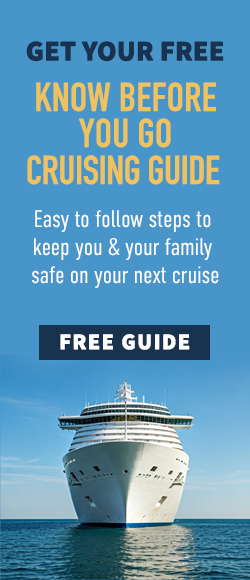BY AMY MARTINEZ
Miami Herald
March 20, 2006
Lawyers turn cruise lawsuits into industry
How many lawyers does it take to sue a cruise line?
Only one, or one too many if you’re the cruise line.
The $25 billion-a-year cruising industry has faced more lawsuits than it cares to count over the past few decades — some 2,100 in South Florida alone since 2001.
Many are filed by a small group of lawyers — about 15 locally — who specialize in representing injured cruise passengers and crew members and make up a thriving cottage industry in South Florida.
But the cruise lines aren’t exactly sitting back — far from it. They have teams of lawyers to fight or settle the suits, and they’ve quietly begun putting into place measures to make it more difficult to sue them.
William Huggett was the leading adversary of cruise lines before his death in 2004. The big three now: Charles Lipcon, Brett Rivkind and James Walker.
Their typical case is the passenger who slips and falls, or the waiter with chronic pain from years of carrying large food trays. They settle most cases before reaching trial, rarely attracting attention outside the cruise community.
But that has changed amid increased scrutiny over missing cruise ship passengers, namely Connecticut honeymooner George Smith, whose disappearance last summer has prompted two Congressional hearings in the past three months and become a fixture on cable TV news shows.
Rivkind and Walker are representing members of the Smith family and have gone on TV to argue that cruise lines aren’t doing enough to protect their passengers from injury or death. An online directory of frequently quoted people now includes a link to ”Brett Rivkind quotes,” all on the Smith case.
The cruise lines argue that the lawyers are drawing an inordinate amount of attention to an industry with a remarkably strong safety record and have put their own lawyers on TV to counter the criticisms.
Cruise line executives declined to discuss their strategies for reducing the number of suits, and they chose their words carefully when asked what they think of lawyers who sue them.
“It’s a free country,” said Colin Veitch, CEO of Norwegian Cruise Line, during a convention last week in Miami Beach. “Everyone is free to sue everyone else.”
The lawyers — who work on contingency and get paid 30 percent to 40 percent of any settlement or jury verdict — are benefiting from growth in cruising overall.
About 11.2 million people took cruises last year, more than twice as many as a decade ago, making cruising the fastest-growing segment of the worldwide travel industry.
“As the cruise lines have gotten bigger, I’ve had more work to do,” said Lipcon, a Miami lawyer who’s been suing cruise lines for more than 30 years.
PRIME LOCATION
For lawyers interested in suing cruise lines, South Florida is the place to be.
Cruise lines require passengers who sue them for whatever reason to do so in state or federal court near their headquarters, usually in South Florida. The requirement is part of the fine print on passenger tickets.
“If you want to do this kind of work, you pretty much have to do it in Miami,” said Martin Davies, a maritime law professor at Tulane University.
Davies said plaintiffs’ lawyers occasionally try to sue somewhere else, but they almost always fail. The perception is that the cruise lines are getting a hometown advantage. Davies disputes that, arguing that it makes sense for cruise lines to be able to limit the number of places where passengers can sue. “Their passengers come from all over the world,” he said.
The cruise lines won’t say how much money they spend on lawsuits, but most cases do get settled, with payouts ranging from a couple thousand dollars to more than $1 million.
Last week, Rivkind won a $3.3 million verdict from a Miami jury against Carnival Cruise Lines on behalf of a Peruvian crew member who believes he suffered a stroke because of inadequate medical care while on the job.
Carnival has nine lawyers dedicated to defending personal-injury claims at its Miami headquarters, said general counsel Arnaldo Perez. The lawyers generally handle cases until they reach trial, then turn them over to outside counsel.
In 2003, Carnival changed its place for passengers to sue from state court to federal court, a move some believe was designed to discourage plaintiffs’ lawyers. Rivkind noted that federal judges require all motions to be put in writing, meaning more work.
Indeed, the number of South Florida filings against cruise lines peaked in 2003 at 511 and declined in each of the past two years, to 386 in 2005.
Also, cruise lines have begun including ”arbitration” requirements in their contracts with new crew members in an attempt to curtail filings. The contracts require crew members to go before an arbitration panel to resolve grievances against the cruise lines.
ARBITRATION REQUIRED
Cruise lines started requiring arbitration after a ruling last year by the U.S. Court of Appeals in Atlanta.
The court ordered the families of Filipino crew members killed in a boiler explosion aboard the SS Norway to settle their claims in their homeland, upholding an employment agreement between the Philippines and the ship’s operator.
In doing so, the court signaled that it would look favorably on arbitration requirements, said Curtis Mase, whose Miami law firm defends cruise lines against personal-injury claims.
The cruise lines say the employees benefit from arbitration because it takes less time and money than filing a lawsuit.
Plaintiffs’ lawyers say they worry that injured crew members will receive smaller payouts than they have in the past, especially if they’re required to pursue arbitration outside the United States.
“It’s a $25 billion industry. They can’t parcel out a few pennies for these guys who make the industry work?” said Walker, who has handled 250 cases against cruise lines since the late-1990s.
Meanwhile, lawyers on both sides don’t expect to be out of a job anytime soon.
“The bottom line is, we don’t see any abatement in these suits,” Perez said. ‘Plaintiffs’ lawyers love to come after companies with deep pockets.”








